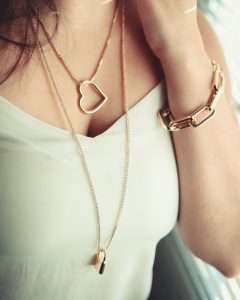
Everyone loves the sound of 24K gold. Pure gold is associated with being very valuable, the “best of the best” when it comes to owning gold or giving a gift. And while it’s true that it is the most valuable, it actually isn’t the best choice when it comes to owning gold jewelry. As romantic as it may sound saying your partner got you a 24-karat gold necklace, that gift actually isn’t very practical.
That’s because gold by itself isn’t very durable. When mixed with other alloys, however, gold becomes stronger and better for long-time, everyday use. For this reason, choosing a less pure karat is a better choice when it comes to purchasing gold jewelry. However, there are other reasons people may opt for higher karat jewelry. Below, we’ll examine a few different reasons why people make these choices.
But first, what exactly is a karat, and why does it matter? To learn more about gold purity, how it’s measured, and the value implications, check out our article: What is Gold Purity and How is it Measured? Comparing 24k, 22k, 18k, 14k, 12k, and 10k Gold.
Gold that is used purely for investment (like bars or coins), is generally 24k gold. Of course, those aren’t “for everyday use” in the 21st century. No one is really chipping off pieces of gold to buy their groceries these days. By everyday use, I mean things like rings (including wedding bands), necklaces, bracelets, earrings, and other jewelry.
18 Karat Gold for Everyday Use
18K gold is often considered an excellent choice for jewelry, but whether it’s the best depends on your specific needs and preferences.
If you have an active lifestyle or are on a tighter budget, you might prefer the increased durability and affordability of 14K or 10K gold. Similarly, if your skin is sensitive to other metals, it could discolor or otherwise react poorly to lower karat jewelry.
If you’re not very hard on your jewelry, then 18k can be a good choice. So for those that prefer fine dining and golf to scuba diving and hand-to-hand combat, 18k gold is a perfectly fine choice.
When it comes to giving a gift of gold, if you want the gift to be a combined expression of value and practicality, then 18k gold is your best bet. It’s quite a bit more valuable than 10k and 14k gold (80% more valuable than 10k gold, to be exact), is less likely to react negatively with skin, and is still durable enough for basic everyday use.
For what I’d call “special occasion jewelry,” 18k gold is definitely a great choice. It’s brighter color and higher value have an air of opulence, and for such occasions you’re really not worried about wear and tear.

14 Karat Gold for Everyday Use
When it comes to everyday gold use, I’m a 14k gold guy. I like to stay active, so any jewelry I wear needs to be prepared for a bit of action. Here are some reasons why 14K gold can be considered a good choice for jewelry:

While it may not be a great idea to challenge your partner on their allergy if they say they’re allergic to “fake” gold, generally speaking 14k gold is hypoallergenic. My mom’s skin would react to costume jewelry, but not 14k gold, for example. My ex-girlfriend claimed 10k was no good, while 14k was acceptable, so take from that what you will. I didn’t test her on it, but consider me skeptical.
All in all, if you value durability and affordability, 14K gold can be a strong choice. However, if ever there comes a time to sell it, you’ll be getting significantly less for it than if you had invested in a higher karat count.
Selling Your Gold
If you’re thinking of selling your gold, at Cash for Gold Mailer we’ll give you a great price for your gold. Whether you’ve got 14k or 18k gold – or if you aren’t sure – we’ll evaluate your jewelry and send an offer to buy your gold from you within 24 hours.
Ready to get started? Request a free gold mailer now!
POSTED IN: 14k gold, 18k gold, Gold Purities, Hypoallergenic Gold, Physical Gold, Selling Wedding Bands, Selling Wedding Rings
By submitting your information you agree to our
Privacy
Policy and Terms and Conditions.


